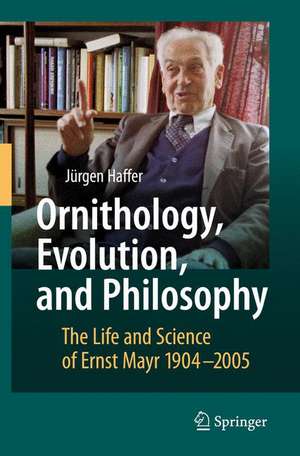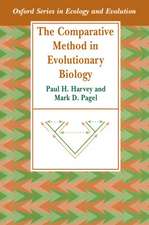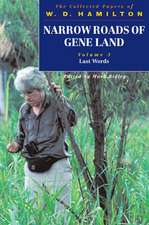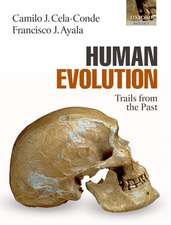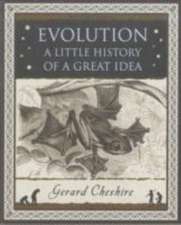Ornithology, Evolution, and Philosophy: The Life and Science of Ernst Mayr 1904-2005
Autor Jürgen Hafferen Limba Engleză Paperback – 19 noi 2007
Preț: 926.34 lei
Preț vechi: 1129.68 lei
-18% Nou
Puncte Express: 1390
Preț estimativ în valută:
177.31€ • 192.66$ • 149.04£
177.31€ • 192.66$ • 149.04£
Carte tipărită la comandă
Livrare economică 21 aprilie-05 mai
Preluare comenzi: 021 569.72.76
Specificații
ISBN-13: 9783540717782
ISBN-10: 3540717781
Pagini: 476
Ilustrații: X, 474 p. 71 illus.
Dimensiuni: 155 x 235 x 27 mm
Greutate: 1.46 kg
Ediția:2007
Editura: Springer Berlin, Heidelberg
Colecția Springer
Locul publicării:Berlin, Heidelberg, Germany
ISBN-10: 3540717781
Pagini: 476
Ilustrații: X, 474 p. 71 illus.
Dimensiuni: 155 x 235 x 27 mm
Greutate: 1.46 kg
Ediția:2007
Editura: Springer Berlin, Heidelberg
Colecția Springer
Locul publicării:Berlin, Heidelberg, Germany
Public țintă
Professional/practitionerDescriere
Ernst Mayr (1904–2005), eminent naturalist-systematist and ornithologist, “- chitect” of the Synthetic Theory of Evolution, leading evolutionary biologist and in?uential historian and philosopher of biology, was asked repeatedly by friends, associates, and peers to write an autobiography, but he always declined such s- gestions because he considered those of other people he knew as inadequate. Moreover, he could not very well talk about himself without bragging, which did not appeal to him. Who else has had a private dinner with the Emperor and - pressofJapan?WhoelsehashadhonorarydegreesfromtheUniversitiesofOxford, Cambridge, Harvard, the Sorbonne, Uppsala, and Berlin? And who else has been able to celebrate the 75th anniversary of his PhD? He also published several au- biographicalaccounts,dictatedcopiousautobiographicalnotes,andannotatedhis bibliography. I had the privilege of using these notes and, in addition, of asking him numerous questions, which he answered patiently in many personal letters. He supported the plan of a biography wholeheartedly from the beginning and reviewed a ?rst draft in detail. In many ways he should be considered a coauthor of this book. As a high school student and eager birdwatcher in Germany, I read Kramer’s (1948) extensive review of Mayr’s Systematics and the Origin of Species (1942e) and was impressed with the general evolutionary relevance of the discussions and conclusions in this book based, in large part, on his ornithological studies.
Cuprins
The young naturalist in Germany. Childhood and youth. The family. Birdwatching. The duck with a red bill. University student in Greifswald and Berlin. Friendships at school and university.- The budding scientist. PhD thesis and examination. The influence of teachers. Erwin Stresemann – teacher and friend. Assistant curator at the Museum of Natural History in Berlin. Expeditions to New Guinea and the Solomon Islands.- Ornithologist in New York. The New York years (1931 – 1953). Emigration to the United States and life in New York City. Curator of ornithology at the American Museum of Natural History. Ornithologist and zoogeographer. Birds of Oceania. Birds of Australia, the Malay Archipelago, and SE Asia. Descriptions of new species and subspecies of birds. Zoogeography.- Biological species and speciation – Mayr’s first synthesis. A modern unified theory of evolution. Community architect.- Life in New York during World War II. New York City and Tenafly, New Jersey. Cold Spring Harbor (1943 – 1952). Citizenship.- Professor of Zoology at Harvard University. The Harvard years (1953 – 2005). Teaching and PhD students. Director of the Museum of Comparative Zoology. Evolutionary biology – Mayr’s second synthesis. Overviews of evolutionary biology. Integrated gene complexes versus beanbag genetics. Animal Species and Evolution. Behavior and evolution. Particular topics of evolutionary biology.-Ernst Mayr – The man. Personality and general views. Health. The farm near Wilton, New Hampshire. Residence in Cambridge, Massachusetts. Advisor to the National Academy of Sciences and the NSF. National and international recognition.- Systematics and classification. Diversity. Classification. Zoological nomenclature.- History and philosophy of biology – Mayr’s third synthesis. History of biology. Philosophy of biology.-
Recenzii
From the reviews:
"Haffer’s book is clearly … for historians and philosophers of science, for evolutionary and other biologists with an interest in one of the eminent personalities in their field in the 20th century, and for advanced students in biology and philosophy, which already have a background in the philosophy and history of evolutionary biology. … a fascinating piece of historical analysis and description. It is now and will always be the initial point for any historical work on Ernst Mayr … ." (Michael Ohl, Zoosystematics and Evolution, Vol. 84 (2), 2008)
"To provide both a biography of Ernst Mayr and an interpretive overview of his scientific contributions in a single book is a daunting task, but Jürgen Haffer succeeds admirably. … Throughout the book, Haffer blends a chronology of Mayr’s personal life with an analytical review of his contributions to various disciplines. … The book is a good read for anyone interested in evolutionary ideas, in how science progresses, or in the career of an amazing scientist." (M. Ross Lein, Ibis, Vol. 150, 2008)
"In Ornithology, Evolution, and Philosophy, Jürgen Haffer chronicles Mayr’s life and his research. …the book will be useful not only to Mayr scholars but also to anyone wishing to understand the progress of evolutionary biology through the last century." (Trevor Price, Bioscience, Vol. 54 (2), February, 2009)
"Jürgen Haffer opens his biography of Ernst Mayr with an overview of his elegant, comprehensive work: the ornithologist, evolutionist and historian/philosopher of biology is described in detail. … Haffer’s monograph … will become a classic in the literature on the history of twentieth century biology. … This first biography, which contains many unpublished photographs such as a picture showing ‘the three Mayr brothers in Kempten (Allgäu, Bavaria), August 1907,’ will certainly open a series of books on Ernst Mayr and his outstanding scientific achievements." (U. Kutschera, Evolution: Education and Outreach, Vol. 2 (3), 2009)
"Haffer’s book is clearly … for historians and philosophers of science, for evolutionary and other biologists with an interest in one of the eminent personalities in their field in the 20th century, and for advanced students in biology and philosophy, which already have a background in the philosophy and history of evolutionary biology. … a fascinating piece of historical analysis and description. It is now and will always be the initial point for any historical work on Ernst Mayr … ." (Michael Ohl, Zoosystematics and Evolution, Vol. 84 (2), 2008)
"To provide both a biography of Ernst Mayr and an interpretive overview of his scientific contributions in a single book is a daunting task, but Jürgen Haffer succeeds admirably. … Throughout the book, Haffer blends a chronology of Mayr’s personal life with an analytical review of his contributions to various disciplines. … The book is a good read for anyone interested in evolutionary ideas, in how science progresses, or in the career of an amazing scientist." (M. Ross Lein, Ibis, Vol. 150, 2008)
"In Ornithology, Evolution, and Philosophy, Jürgen Haffer chronicles Mayr’s life and his research. …the book will be useful not only to Mayr scholars but also to anyone wishing to understand the progress of evolutionary biology through the last century." (Trevor Price, Bioscience, Vol. 54 (2), February, 2009)
"Jürgen Haffer opens his biography of Ernst Mayr with an overview of his elegant, comprehensive work: the ornithologist, evolutionist and historian/philosopher of biology is described in detail. … Haffer’s monograph … will become a classic in the literature on the history of twentieth century biology. … This first biography, which contains many unpublished photographs such as a picture showing ‘the three Mayr brothers in Kempten (Allgäu, Bavaria), August 1907,’ will certainly open a series of books on Ernst Mayr and his outstanding scientific achievements." (U. Kutschera, Evolution: Education and Outreach, Vol. 2 (3), 2009)
Notă biografică
Jürgen Haffer was born in 1932. He majored in geology and paleontology obtaining a PhD degree at the University of Göttingen in 1957. He became an exploration geologist and lived in South and North America, Iran, Egypt, and Norway. During these assignments he studied the bird faunas of Amazonia and Iran and has been in close communication with Ernst Mayr since the early 1960s. He also co-published a biography of Erwin Stresemann, Mayr’s teacher and friend in Berlin, Germany.
Textul de pe ultima copertă
This book is the first detailed biography of Ernst Mayr. He was an ‘architect’ of the Synthetic Theory of Evolution, and the greatest evolutionary biologist since Charles Darwin, influential historian and philosopher of biology, outstanding taxonomist and ornithologist, and naturalist. He is one of the most widely known biologists of the 20th century.
Mayr used the theories of natural selection and population thinking as theoretical models within the framework of historical biological studies. He suggested that various competing paradigms may exist side by side and more or less pronounced ’revolutions’ may occur in different fields from time to time. Changes of concepts have a much stronger effect on the development of biological sciences than the discovery of new facts. Mayr was the first to emphasize the role of biopopulations, thereby pointing out the basic difference between ’population thinking’ and typological essentialism. Population thinking takes into consideration the uniqueness of each individual and unlimited variation of populations which may lead to the development of new species. On the other hand, typologists assume that the unchanging essence of each species determines variation and fixed limits of variation preclude speciation from occurring except through saltation.
Jürgen Haffer majored in geology and paleontology obtaining a PhD degree at the University of Göttingen. He became an exploration geologist and lived in South and North America, Iran, Egypt, and Norway. During these assignments he studied the bird faunas of Amazonia and Iran and has been in close communication with Ernst Mayr. He also co-published a biography of Erwin Stresemann, Mayr’s teacher and friend in Berlin, Germany.
Mayr used the theories of natural selection and population thinking as theoretical models within the framework of historical biological studies. He suggested that various competing paradigms may exist side by side and more or less pronounced ’revolutions’ may occur in different fields from time to time. Changes of concepts have a much stronger effect on the development of biological sciences than the discovery of new facts. Mayr was the first to emphasize the role of biopopulations, thereby pointing out the basic difference between ’population thinking’ and typological essentialism. Population thinking takes into consideration the uniqueness of each individual and unlimited variation of populations which may lead to the development of new species. On the other hand, typologists assume that the unchanging essence of each species determines variation and fixed limits of variation preclude speciation from occurring except through saltation.
Jürgen Haffer majored in geology and paleontology obtaining a PhD degree at the University of Göttingen. He became an exploration geologist and lived in South and North America, Iran, Egypt, and Norway. During these assignments he studied the bird faunas of Amazonia and Iran and has been in close communication with Ernst Mayr. He also co-published a biography of Erwin Stresemann, Mayr’s teacher and friend in Berlin, Germany.
Caracteristici
Biography of one of the greatest biologists of the 20th century
Includes supplementary material: sn.pub/extras
Includes supplementary material: sn.pub/extras
